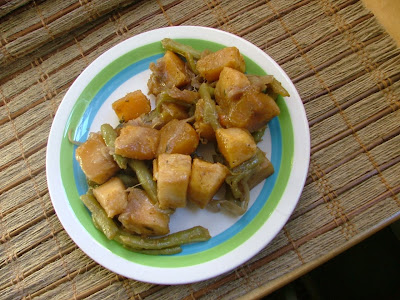We're all tightening our belts. As grocery prices rise, cutting corners on your household's food budget is imperative. But what about all those luscious, luxurious, and decadent foods you miss? I propose a solution. Liver Pate.

Now before you roll your eyes and flare your nose in disgust, please, hear me out. I'm guessing that few would argue with me that foie gras is the upper echelon of expensive, elite food. Now, think about all the things to love about foie gras. It's
unctuous, melty-quality. It's smooth texture. It's rich layers of earthy flavor that are strong, but not aggressive. Humble liver pate has these same qualities, without the inhumanely force-fed goose.
I'm going to admit it, I used to be part of the liver pate uninitiated. For years, I lived with my ignorance. When I waited tables at Johnny's Cafe, the first weekend of every month was a two-day event of complementary liver pate served to every guest. I would use an ice cream scoop to plop a glop of cat food-like pate on a serving dish and bring it to guests with their bread and crackers. In all this time, I never tired the liver pate. Not even once. What I did observe though, was how polarizing pate is. Those that loved it had such a positive explosion on their palate that it sometimes made their eyes roll back in their head! Many guests came in expressly FOR Liver Pate weekend. For the ignorantly uninitiated, I found that if I did not tell people that it was liver, they would try it and enjoy it. But sadly, it took me nearly seven years (I am ashamed to admit how much delicious, liver based joy I missed out during that time) to try, to enjoy, and to fall utterly in love with liver pate.

It started two summers ago when my husband was out of town. When Kent's gone, I see it as a license to cook incredibly strange food. That summer I had several yellow summer squash plants that were as reproductive as a large colony of rabbits. I decided the only thing to do was to begin aborting squash fetus by eating as many squash blossoms as I could. (Squash plants have both male and female blossoms. It's important if you want to do reproductive damage to eat as many of the female blossoms as possible because only the females turn into squash). The only recipe I had for squash blossoms was from Fannie Farmer, and it involved stuffing the blossoms with a mixture of parsley, bread crumbs, chicken liver, and onions bound together by a beaten egg. All in all it was a perfect gateway recipe for liver. I found the novelty of eating squash blossoms, the beauty of their orangey color out-weighed any hesitation I had toward liver. I could only buy chicken livers in 1 lbs tubs, and I couldn't bring myself to throw out the rest. Again I turned to Fannie Farmer and made her liver pate. (Also while Kent was out of town.) It was quite addictive. I made several meals out of liver pate on Saltines with yellow mustard and a glass of red wine.
The most fearful thing about new foods is unrealistic aversion to the unknown. I think many people equate chicken liver with the shoe leathery slabs of beef liver fried in onions (which when prepared correctly, are delicious in their own right). Chicken livers are much milder than beef livers, and when made into pate, the texture is heavenly smooth.
Now, the great thing about chicken liver pate, aside from how decadent, elegant, and luscious it is is the fact that chicken livers are ridiculously cheap. A pound of chicken livers is usually about $1.00!
After I began making liver pate, I found that I sometimes I would get intense cravings for it. Particularly, when my body was telling me I need to bulk up on iron, like when I'm premenstrual. (My friends report craving hamburgers when their PMSing, not me, give me the chicken livers.) Chicken livers are incredible high in iron, so if you need to get more iron in your diet because of health reasons chicken livers are a great way to medicate through nourishing food, weather you're anemic or undergoing chemotherapy.

Honestly, I'm completely unbiased toward liver pate recipes. I like how dark and slightly spicy Fannie Farmer's recipe for pate is, but I also adore the lighter, creamier, and less butter laden version from Bon
Appetit (September 1999) which you can find
here. I also like how the garnish of a few wine-soaked figs and walnuts or pistachios really elevates this food to quite elegant proportions.









